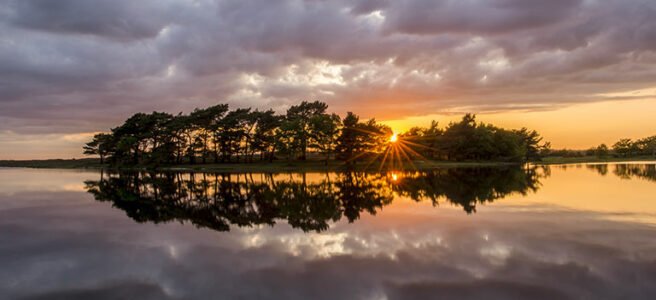The New Forest is steeped in heritage, history and wrapped in tales of folklore, fables and stories from yesteryear. Some are scary, some quizzical and some just darn right weirdly strange. These stories have taken shape through the time-honoured art form of storytelling, interwoven with artistically inclined authors.
Come and see the landmarks and untamed landscapes of the New Forest yourself and book a break in one of our New Forest cottages.
The Rufus Stone
William the Conqueror created the New Forest soon after he arrived in England as his Royal hunting ground. When he passed away, the crown, and subsequently the New Forest, was inherited by his son, William, who because of his red hair was known as ‘Rufus’. King Rufus was not a popular king, and after just 13 years of reign, in 1100AD he was killed (supposedly) in an accident while out hunting by one of his party – Sir Walter Tyrrell. The story goes that Sir Walter’s arrow ricocheted off a nearby oak tree before plunging into the chest of King Rufus. The incident is shrouded in a cauldron of murder, assassination, coincidence and mishap, with Sir Walter Tyrrell fleeing the scene, as quickly as William the Conqueror’s brother Henry crowned himself king. A stone – the Rufus Stone – stands as a monument on the spot where William died, and the area surrounding his untimely death is said to be haunted.
View this post on Instagram
The Bisterne Dragon
A couple of hundred years later, the 1400s to be exact, a rather nasty dragon from Burley Beacon was unleashing a wave of terror on the village of Bisterne. Folklore says that Sir Maurice de Berkeley, who lived in a nearby manor, recruited the help of an old man’s two dogs to fight the Dragon. After long combat across the forest, Sir Maurice, with the aid of his two hounds, slew the Dragon just outside the village of Lyndhurst. A large mound known as Bolton’s Bench marks the grave where the Dragon died. It’s said the Dragon was possessed by evil, and Sir Maurice never recovered from the turmoil of his battle with the Dragon. Haunted by voices in his head, nightmares and madness, he went to the spot where he killed the Dragon, laid down and died. His final resting place is marked by yew trees, creating the eye-catching and iconic New Forest landmark.
View this post on Instagram
Smugglers and Highwaymen
There’s a somewhat romantic connotation about smugglers and highwaymen from books and fantasy films of robbing the rich and sometimes helping the poor. Yet the reality is they were large gangs of hardened criminal thugs, wrapped up in a world of murder, brutality and beatings who harassed and intimidated locals. The New Forest in the 1700s was a favourite playground for them to socialise, plan, rob, smuggle and store loots, including brandy, tobacco, tea and fine silks. Once landed, their stolen bounty would be transported by horse and cart or through a maze of underground tunnels to pubs and storehouses. The towns and villages of Lymington, Barton, Sway, Burley and Hinton are just some of the locations where the tunnels are said to run – ask in the local pubs and you’re sure to find out more!
View this post on Instagram
Landmark Trees
Near Lyndhurst is the ‘Knightwood Oak’. Reputed to be the oldest tree in the New Forest at approximately six hundred years old, its mighty branches supposedly sheltered King Henry VIII during a hunt. The ‘Naked Man’ is another oak tree with a more sinister history, as it is said to be the tree that smugglers, thieves and highwaymen were hung. Unfortunately, its herculean trunk and enormous branches are long gone. All that remains now is its fenced-off stump, which you can visit on Wilverley Plain.
View this post on Instagram
The New Forest Shakers
Mary Ann Girling founded a religious cult called the New Forest Shakers, which was also known as ‘The People of God’ in the New Forest during the late 1870s. Girling preached celibacy, chastity, forbade any form of the buying or selling of goods and prepared her worshipers for the second coming of Christ. At its peak there were more than 140 followers eking out a lowly self-sufficient life in very little comfort at their base in New Forest Lodge in the village of Hordle. Girling ruled her followers with an iron fist, preaching and screeching her sermons armed with carving knives, scales of justice, forks and swords in her hand. She certainly attracted attention and even support from prominent figures, none more so than Andrew Peterson, a local judge. Money ran out for the New Forest Shakers, and their stay at New Forest Lodge abruptly ended on a cold December night when Girling along with her followers were evicted. After Girling died of cancer in 1859, Judge Andrew Peterson wanted a lasting monument in recognition of The New Forest Shakers. He built a tower just outside the village of Sway known locally as Sway Tower or Peterson’s Folly, which can be seen for miles around.
View this post on Instagram
Take a look at our full portfolio of New Forest Cottages

